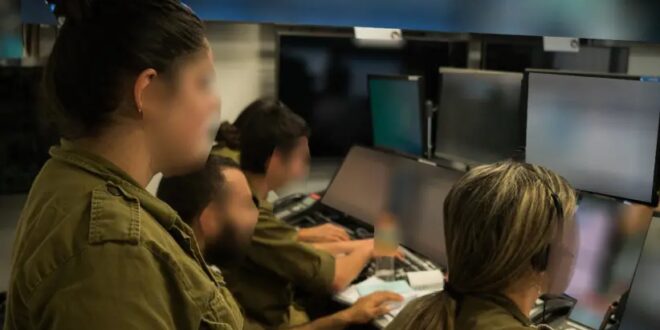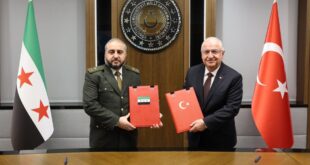Behind the scenes of targeting Hamas terror targets
Operation Guardian of the Walls lasted 11 days, but it was one of the most intense wars between Israel’s military and Hamas and Palestinian Islamic Jihad terrorists in the Gaza Strip.
By many measures, this round was the most intense escalation since Operation Protective Edge in 2014. Following rocket fire on Jerusalem by Hamas, Israel began striking targets with the intention of severely degrading the military capabilities of the terror groups in an attempt to bring about long-term deterrence and calm.
Despite the relative quiet on the southern front in recent months, the IDF was busy scouting thousands of targets in the densely populated Strip over the past two years, fully expecting another round of fighting to break out at any moment.
Hundreds of targets were struck by the IDF mainly from the air in response to the over 4,000 rockets and missiles fired by the terror groups. Information on hundreds of the targets hit were gathered in real-time, including missile launchers that were aimed at Tel Aviv and Jerusalem.
Other targets included rocket launchers, rocket manufacturing, production and storage sites, military intelligence offices, drones, residences of commanders, and Hamas’s naval commando unit where Israel has destroyed most of the infrastructure and weaponry, including several unmanned autonomous GPS-guided submarines that can carry 30 kilograms of explosives.
The IDF also targeted several high-rise buildings, including in the affluent neighborhood of Rimal.
Lieut.-Col. (Res) T. commanded the team behind the strike on one such building, the 14-story Shorouq tower located in the center of Gaza City. It was the third such high-rise building destroyed by the IDF in the operation that began May 10.
The building that the IDF says had housed Hamas military intelligence offices was struck in the afternoon hours “when there were fewer people in the building,” he said.
According to the officer, the offices were situated on two floors and were “more interior which made it almost impossible to hit” without destroying the entire building. The building also housed a dental clinic that was closed because of the fighting. “But we called the owners and made sure they came to get their equipment first.”
“We don’t try to destroy” for the sake of it, he said. “We want to cause minimal damage to civilians but we won’t give up just because it’s in a civilian building in a civilian area. We didn’t have a choice.”
T. said his role was to use all the intelligence available to make sure that there were no civilian casualties in the strikes targeting the groups’ infrastructure.
“The planning is very precise, and we use our intelligence assets to reach those who live in the buildings and those surrounding it to make sure that they leave,” the officer said.
Before the IAF destroys a building, it delivers a non-lethal warning hit to the roof of the building known as “knocking on the roof” shortly before delivering the bombs that bring down the building.
That warning “does not give Hamas the time to take out anything from the building,” he said.
T said that it was Hamas and PIJ who were attacking Israel with long-range missiles, and “we struck back because we were attacked.”
According to him, Israel “had better intelligence that was more precise,” and that caused less civilian casualties and more combat casualties.
The Hamas-run health ministry in Gaza said at least 243 Palestinians were killed during the fighting, including 66 children and teens, and that 1,910 people wounded. The IDF says over 100 terror operatives were killed, and that many of the civilian casualties were caused when Hamas rockets fell short of their intended targets, or because civilian homes collapsed after an airstrike on Hamas’s tunnel network.
Hamas Gaza leader Yehya Sinwar told the Associated Press last week that 80 operatives were killed in the fighting, 57 affiliated with Hamas and 22 with Palestinian Islamic Jihad.
Lieutenant (res) E was a firepower officer in a strike team responsible for coordinating intelligence with the IAF in real-time on Hamas’s military infrastructure. Her main goal, she said, was to hit terror targets without damaging non-terror infrastructure, or killing anyone, both combatants and civilians.
According to E, there are several kinds of strikes: those targeting people and others hitting military infrastructure.
“Even if we knew that there was someone who was an operative, we did everything we could to make sure there was nobody in the area,” she said. “If there was an operative we would get him in another way, another strike.”
Each strike can take hours to execute to ensure that innocent civilians were not harmed, she said, adding that there were several times that the IDF called off an airstrike “because civilians were in the area. We did that in real-time.”
E said that following the “knock on the roof” warning, “Hamas understood that we were preparing to strike and wouldn’t approach the area. It’s not new to them. It’s not that they don’t know we are going to strike – they know and they leave.”
According to E, the terror groups “don’t have the time to take their weapons. There’s not really any time in the short time-frame that we give them to remove their infrastructure. It’s not just one rocket or one laptop… But should anyone approach the area, we understand that it’s terror-related.”
The decision to place military infrastructure in civilian areas contravenes the laws of armed conflict, but according to E, “it’s not that they don’t care – they take advantage. Hamas places their military infrastructure within civilian infrastructure, and if we hit a building that has munitions inside, the IDF can’t control the explosion.”
Hamas’s underground tunnel network dubbed “the Metro” was also heavily damaged in the air strikes. Military sources said they were able to map the network consisting of hundreds of kilometers of tunnel under residential areas to a degree where they knew almost everything about them.
The mapping of Hamas’s underground network was done by a massive intelligence-gathering process helped by the technological developments and use of Big Data to fuse all the intelligence.
Once mapped, the IDF was able to create a full picture of the network both above and below ground, with details such as the depth of the tunnels, their thickness, and the nature of the routes. With that, the military was able to construct an attack plan that was used during the operation.
While the IDF acknowledges that it hasn’t destroyed the entire network, it asserts that it struck parts of the network that makes it nearly impossible for Hamas to use it again. And, the ability of the IDF to crack Hamas’s network and completely map it removes one of the central dimensions of Hamas’s combat strategy.
“Years of work, outside-the-box thinking and the fusion of all the resources of the intelligence division together with elements in the field led to the a breakthrough solution of the underground network,” a senior officer in the intelligence division said last week.
Staff Sgt. E. worked on the plan for four months before the fighting broke out, and was surprised when she heard that the network was going to be hit.
“I didn’t think it was going to happen until the planes were in the sky,” she said. “During the strikes, we were surprised as a lot of people worked on this for years.” The fighting was “very dynamic,” she said, and they were always preparing what was going to be hit next.
“I think at the end of the day, Hamas was surprised as to how much we knew about their underground network,” said St.-Sgt. E. “They didn’t expect it. We showed the enemy that they can’t do everything that they want without us knowing.”
But according to Sinwar, Israel only destroyed 5% of the network as the group has over 500 kilometers of tunnels under the blockaded enclave.
“Israel failed to direct a strike to kill the political, military, and security leadership [of Palestinian resistance groups] and destroy their command and control rooms,” he told journalists in Gaza after the ceasefire came into effect.
Sinwar also warned that the group has 10,000 “martyrs” inside Israel who are “ready to respond” if Jerusalem is harmed.
St.-Sgt. E, from Ashdod, said that she had to detach herself from the rocket attacks that were targeting her home city.
“There are rockets flying over my house, and I was sitting here being professional and not with my family in our shelter.
I had to separate myself between what was happening and what was happening to my family and my country so that I could do my job.”
In an interview with Channel 12 News, the head of the UN Palestinian refugee agency in Gaza, Matthias Schmale, acknowledged that while the “viciousness and ferocity of the strikes was heavily felt, ” he had “the impression that there is a huge sophistication in the way the Israeli military struck.”
According to Lt.-Col. T, the strikes “caused a lot of damage to their infrastructure and manufacturing. In my opinion, the strikes were more effective than those of 2014, despite the fact that the war was longer.”
Though the ceasefire was signed, “we could have continued for a long time, we were ready then and we can continue now if they launch rockets.”
According to Lt.-E, Hamas does not differentiate between targets. “For them, everything is kosher,” including the launching of rockets toward Jerusalem that brought about this round of war.
The IDF would not have let rockets hit the Temple Mount,” Lt. E said. “The difference between Israel and Hamas is that the IDF would have used the Iron Dome to intercept them, but Hamas fired their rockets toward it.”
Operation Guardian of the Walls was not Lt. E’s first war with Hamas. She took charge of over 80 reconnaissance troops in the command and control room in Kissufim in southern Israel in 2014, and Operation Protective Edge broke out a week later.
“Now everything has changed,” she said. “The character of the targets, how we make decisions. The ability to bring about an end of the operation within 11 days using only airstrikes and no troops maneuvering inside Gaza and risking the lives of many troops is critical. The achievement of this round is that Hamas knows they can’t fire a rocket or carry out any attacks on Israel without a response.”
 Eurasia Press & News
Eurasia Press & News




